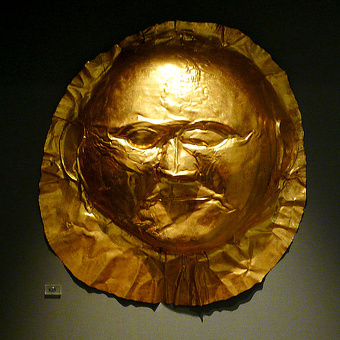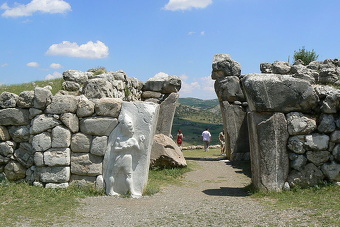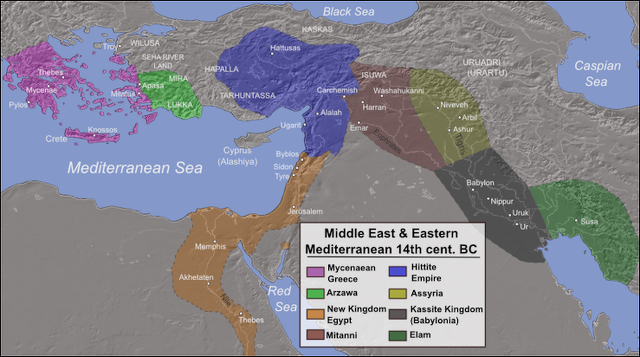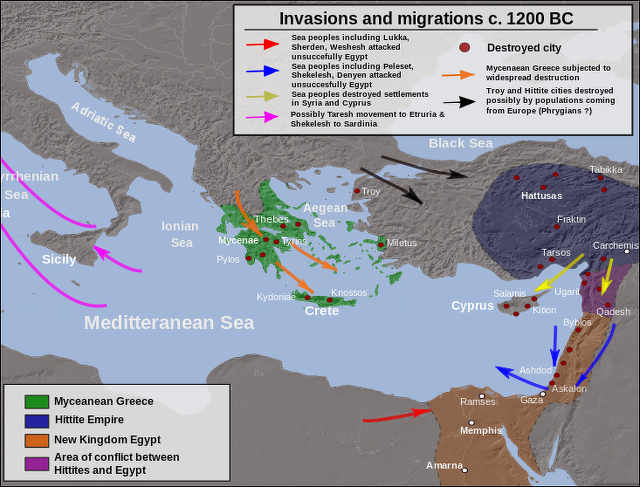Home | Category: Assyrians / Hittites and Phoenicians / New Kingdom (King Tut, Ramses, Hatshepsut) / Canaanites and Early Biblical Peoples
LATE BRONZE AGE COLLAPSE
The Late Bronze Age collapse refers to widespread societal and state collapse during the 12th century B.C. associated with mass migration, and the destruction of cities and believed to have been caused of exacerbated by environmental change. The collapse affected a large area of the Eastern Mediterranean and the Near East, particularly Egypt, eastern Libya, the Balkans, the Aegean, Anatolia, and, to a lesser degree, the Caucasus. It was sudden, violent, and culturally disruptive for many Bronze Age civilizations, and it brought a sharp economic decline to regional powers, notably ushering in the Greek Dark Ages. [Source: Wikipedia]
The Late Bronze Age collapse triggered the collapse of Mycenaean Greek civilization and the Hittite Empire of Anatolia and the Levant. The Middle Assyrian Empire in Mesopotamia and the New Kingdom of Egypt survived but were weakened, Other cultures such as the Phoenicians enjoyed increased autonomy and power with the decline of Egyptian, Hittite and Assyria military presence in West Asia.In what is commonly known as the “Late Bronze Age collapse,” the Hittite Empire and the civilization of the Mycenaean Greeks, as well as many smaller powers and the trade networks that linked them, fell apart. It also led to anarchy, uprisings, civil wars, and rival pharaohs in Egypt, while Assyria and Babylonia suffered famines, outbreaks of disease, and foreign invasions.
Tom Metcalfe wrote in National Geographic: Scholars have struggled for 200 years to explain the collapse as a consequence of volcanic eruptions or earthquakes; piracy, migrations, or invasions; political or economic failures; diseases, famines, or climate change; or even of the spread of iron metallurgy throughout a region dominated by bronze. The historian Eric Clein said in his book "1177 B.C.: The Year Civilization Collapsed" (2014), the reasons for the collapse aren't understood, but they may include a wars, social upheaval, invasions or famines caused by climate changes or triggered by natural disasters. The theories with the most support argue that the shift to a drier and colder climate in the eastern Mediterranean disrupted food production, leading to shortages that exacerbated the cultural and economic problems already occurring in the region.
RECOMMENDED BOOKS:
“After 1177 B.C.: The Survival of Civilizations” by Eric H. Cline (2024) Amazon.com;
“The End of the Bronze Age” by Robert Drews (1993) Amazon.com
“Collapse of the Bronze Age: The Story of Greece, Troy, Israel, Egypt, and the Peoples of the Sea” by Manuel Robbins (2001) Amazon.com;
“The Philistines and Aegean Migration at the End of the Late Bronze Age” by Assaf Yasur-Landau (2010) Amazon.com;
“The Aegean from Bronze Age to Iron Age: Continuity and Change” Between the Twelfth and Eighth Centuries BC” by Oliver Thomas Pilkington Kirwan Dickinson (2006) Amazon.com;
“Sea Peoples of the Bronze Age Mediterranean C.1400 BC–1000 BC” by Andrea Salimbeti (2015) Amazon.com;
“The Luwian Civilization: The Missing Link in the Aegean Bronze Age” by Eberhard Zangger (2016) Amazon.com;
“Climate, Environment and Agriculture in Assyria: In the 2nd Half of the 2nd Millennium BCE” (Studia Chaburensia) by Herve Reculeau (2011) Amazon.com;
“Collapse and Transformation: The Late Bronze Age to Early Iron Age in the Aegean” by Guy D. Middleton (2020) Amazon.com;
Hittites and the Late Bronze Age Collapse
20120209-AnkaraMuseumAlaca2.jpg The fall of the Hittites in the 12th century B.C. coincided with the Late Bronze Age collapse, when several ancient civilizations in Greece, Crete, the Middle East and the Mediterranean were were shaken or decimated. The historian Eric Clein said in his book "1177 B.C.: The Year Civilization Collapsed" (2014) the reasons for the collapse aren't understood, but they may include a wars, social upheaval, invasions or famines caused by climate changes or triggered by natural disasters. [Source: Live Science]
From its position as a great world power, the Hittite Empire quickly collapsed before the 13th-century as an influx of Aegean peoples migrated into western Asia Minor. Many historians say the responsibility for this collapse lies mainly with the "Sea Peoples," who almost conquered Egypt and eventually settled the coastal plain of Palestine. [Source: J. E. Huesman,New Catholic Encyclopedia, Encyclopedia.com]
According to Reuters: Hattusa, the Hititte capital, enclosed by a monumental stone wall with gates adorned with lions and sphinxes, was burned and abandoned. Texts written on clay tablets using the cuneiform script common in the region — detailing Hittite society, politics, religion, economics and foreign affairs — went silent. It was a sudden end. Less than a century earlier, the Hittites under king Muwatalli II and the Egyptians under pharaoh Rameses II fought the famous and inconclusive Battle of Kadesh in 1274 B.C. — waged with thousands of chariots in Syria — and subsequently reached history's first recorded peace treaty. [Source: Will Dunham, Reuters, February 9, 2023]
In February 2023, in a study published in Nature, researchers led by Sturt Manning of Cornell University said an examination of trees alive at the time of the Hittites showed that three consecutive years of severe drought may have caused crop failures, famine and political-societal disintegration that led to the Hittite Empire’s collapse. Reuters reported: The researchers examined long-lived juniper trees that grew in the region at the time and eventually were harvested to build a wooden structure southwest of Ankara around 748 B.C. that may have been the burial chamber for a relative of Phrygia's King Midas, who legend holds turned anything he touched into gold.[Source: Will Dunham, Reuters, February 9, 2023]
See Separate Article: FALL OF THE HITTITE EMPIRE africame.factsanddetails.com
End of the Myceneans
Mycenae collapsed in 1200 B.C., perhaps as result of social unrest brought about after a series of earthquakes or famine, war or trade collapse. When the Hittite empire collapsed many great cities in Asia Minor were sacked. This have disrupted Mycenaean trade routes. Some scholars believe Mycenae was highly centralized and became overextended and collapsed under its own weight. There is no evidence of a foreign invasion or raid by tribes from the north. From the ashes of Mycenaean civilization, classical Greek culture arose several centuries later.
According to the Canadian Museum of History: “So what happened to the Mycenaeans? The answer is that sometime around 1200 B.C. when the Mycenaean civilization was at its peak, it suddenly appears to have collapsed. Some scholars feel we will never know with certainty what happened and why. There are lots of theories: their history of military violence finally caught up with them; natural disaster in an area plagued with earthquakes and volcanic eruptions; the possibility of drought and famine followed by civil uprising. There is evidence of a lot of migration.” [Source: Canadian Museum of History historymuseum.ca]
See Separate Article: MYCENAEANS europe.factsanddetails.com
Late Bronze Age Collapse in Mesopotamia
The Middle Assyrian kingdom (1365- 1056 B.C.) may have been affected by the Late Bronze Age collapse. Aaron Skaist wrote in Encyclopaedia Judaica: The Assyrian eclipse starting about 1200 was only one phase, and a relatively mild one at that, of the upheaval that marked the end of the Bronze Age throughout the Near East, and whose principal cause was the wave of mass migrations that engulfed the entire area.
Tiglath-Pileser I (c. 1115–1077 B.C.) reestablished Assyria's military reputation and, while respecting the common frontier with Babylonia in the south, and holding off the warlike mountaineers on Assyria's eastern and northern borders, laid the foundations for her "manifest destiny" — expansion to the west. An Assyrian campaign down the Tigris to the Babylonian frontier and then up the Euphrates and Khabur rivers to rejoin the Tigris north of Ashur had become an annual event by the time of Tukulti-Ninurta II (890–884); the petty chieftains of the Arameo-Hittite lands west of Assyria learned to expect swift retribution if they did not pay the tribute exacted on these expeditions. The "calculated frightfulness" of Ashurnasirpal II (883–859) was graphically impressed on his visiting vassals by the reliefs he carved on the walls of his new palace at Kalhu (biblical Calah). [Source: Aaron Skaist, Encyclopaedia Judaica, 2005, Encyclopedia.com]

Egyptians battle Sea People
Invasion of the Sea Peoples
It has been said The Sea Peoples annihilated the great Hittite Empire and looked they might do the same to the Egyptians. The Great Harris Papyrus, the longest know papyrus, describes how many people throughout the region were made homeless. ‘The foreign countries plotted on their Islands and the people were scattered by battle all at one time and no land could stand before their arms.’
The Sea Peoples are a hypothesized seafaring confederation that attacked ancient Egypt and other regions in the East Mediterranean before and during the Late Bronze Age collapse (1200–900 B.C,). After the concept of these people was first introduced in 19th century, the Sea Peoples' incursions became a major part of Egyptian history. The famous history Wilhelm Max Müller, even went as far as calling their existence "the most important questions of ethnography and the primitive history of classic nations". [Source: Wikipedia]
The origins of the Sea Peoples has not been documented but there are no shortage of theories that provide arguments that they came from this place and that, primarily places in western Anatolia, the Aegean, the Mediterranean islands or Southern Europe. Although there is no archaeological evidence that backs it up it has been suggested that the Sea Peoples sailed around the eastern Mediterranean and raided various locations in Anatolia, Syria, Phoenicia, Canaan, Cyprus, and Egypt toward the end of the Bronze Age.
See Separate Article: SEA PEOPLES africame.factsanddetails.com
Mycenaeans, New Kingdom Egypt, and the Hittites All Brought By the Luwians?
Colin Barras wrote in New Scientist: “The Trojan War was a grander event than even Homer would have us believe. The famous conflict may have been one of the final acts in what one archaeologist has controversially dubbed “World War Zero” – an event he claims brought the eastern Mediterranean Bronze Age world crashing down 3200 years ago. And the catalyst for the war? A mysterious and arguably powerful civilisation almost entirely overlooked by archaeologists: the Luwians. [Source: Colin Barras, New Scientist, May 12, 2016 +++]
“By the second millennium B.C. civilisation had taken hold throughout the eastern Mediterranean. The Egyptian New Kingdom coexisted with the Hittites of central Anatolia and the Mycenaeans of mainland Greece, among others. In little more than a single generation, they had all collapsed. Was the culprit climate change? Some sort of earthquake storm? Social unrest? Archaeologists can’t seem to agree. +++
“Eberhard Zangger, head of international non-profit, Luwian Studies, based in Zurich, Switzerland, says that’s because one crucial piece of the puzzle is missing. Another powerful civilisation in western Anatolia played a crucial role in the downfall. His investigations of the published literature show that western Anatolia is extraordinarily rich in mineral and metal ore deposits, meaning it’s likely to have been an important region in antiquity. Through studies of satellite imagery, Zangger has also found that the area was densely populated during the Late Bronze Age. Only a handful of the 340 large city-like sites he has identified have been excavated. “Some of these sites are so large you can see them from space,” says Zangger. “There’s so much waiting to be found it’s really just mind-boggling.”
“Hittite texts talk of several petty kingdoms in western Anatolia speaking versions of a common language – Luwian. According to Zangger, that means we can legitimately talk of them as forming a Luwian civilisation in their own right. We know from Hittite texts that the Luwian kingdoms sometimes formed coalitions powerful enough to attack the Hittite empire. Zangger thinks that 3200 years ago the Luwians did just that and destroyed the Hittite Empire. Shortly after the demise of the Hittites, Egyptian texts document an attack force they termed the “Sea People”. Zangger says it makes sense to view these Sea People as the Luwians, continuing their campaign for wealth and power and, in the process, weakening and destabilising the Egyptian New Kingdom. +++
“The Mycenaeans, perhaps anticipating an attack on their territory, formed a grand coalition of their own, says Zangger. They sailed across the Aegean and attacked the Luwians, bringing down their civilisation and destroying its key cities like Troy – events immortalised in Homer’s Iliad. On returning to Greece, however, and in the sudden absence of any other threat, Zangger believes the Mycenaeans squabbled and fell into civil war – events hinted at in Homer’s Odyssey. Their civilisation was the last in the area to collapse. +++
“Zangger says that only such a sequence of events fits with the evidence documented in ancient texts across the eastern Mediterranean, and also explains why the archaeological record shows that almost every large city in the region was destroyed in warfare at the end of the Bronze Age. He sets out his ideas in a new book, and on a website that launches in English today. +++
“So what do other archaeologists make of this idea of a lost Luwian civilisation? Many stopped trying to impose this sort of monolithic cultural identity on ancient peoples decades ago, says Christoph Bachhuber at the University of Oxford. “Archaeologists will need to discover similar examples of monumental art and architecture across western Anatolia and ideally texts from the same sites to support Zangger’s claim of a civilisation,” he says. The textual evidence available is mainly from post-Bronze age and it paints a slightly confusing picture, which could be seen as both supporting and undermining Zangger’s theory, says Ilya Yakubovich, a historical linguist at the Philipp University of Marburg, Germany. +++
Zangger’s broader “World War Zero” narrative is also debatable. “He’s bringing in this idea of ancient international warfare,” says Michael Galaty at Mississippi State University. “Most archaeologists would balk at using such terminology.” Bachhuber calls it “big bombastic storytelling” and points out that today, archaeologists are skeptical that ancient narratives like Homer’s approximate historical truth. +++
Zangger, however, says there are several other ancient accounts of the Trojan War that all tell a similar story to Homer. One, written in the first century AD, even refers to now-lost Egyptian monuments that documented the conflict. Despite these criticisms, though, there is near-universal praise for the fact that Zangger’s ideas will raise the profile of Late Bronze Age archaeological research in long-neglected western Anatolia, which can only benefit the scientific community. “He’s really getting the ball rolling to do larger holistic studies of the area,” says Bachhuber. “I’m actually quite excited that he’s bringing attention to this region.” +++
Did a 300-Year Drought Bring Down the Mycenaeans and Hittites
A 300-year drought may have caused the collapse of several Mediterranean cultures, including the Hittites and the Mycenaeans Tia Ghose wrote for Live Science: “A sharp drop in rainfall may have led to the collapse of several eastern Mediterranean civilizations, including ancient Greece, around 3,200 years ago. The resulting famine and conflict may help explain why the entire Hittite culture vanished from the planet, according to a study published in August 2013 in the journal PLOS ONE. [Source: Tia Ghose, Live Science, August 14, 2013]
“The ancient Hittite empire of Anatolia began a precipitous decline around 1,300 B.C. Around the same time, the Egyptian empire was invaded by marauding sea bandits, called the Sea People, and the ancient Mycenaean culture of Greece collapsed. Over the next 400 years, ancient cities were burned to the ground and were never rebuilt...But the cause of this Bronze Age collapse has been shrouded in mystery. Some archaeologists believed economic hardships caused the demise, while others proposed that massive tsunamis, earthquakes or a mega-drought was the cause.
“Past studies looking for drought typically only found evidence showing it occurred for short periods of time, making it hard to make conclusions about the whole period...Toward that end, David Kaniewski, an archaeologist at the University of Paul Sabatier-Toulouse in France, and his colleagues collected ancient sediment cores from Larnaca Salt Lake, near Hala Sultan Tekke in Cyprus. The lake was once a harbor, but became landlocked thousands of years ago.
“A decline in marine plankton and pollen from marine sea grass revealed that the lake was once a harbor that opened to the sea until around 1450 B.C., when the harbor transformed over 100 years into a landlocked lagoon. Pollen also revealed that by 1200 B.C., agriculture in the area dwindled and didn't rebound until about 850 B.C. “This climate shift caused crop failures, dearth and famine, which precipitated or hastened socioeconomic crises and forced regional human migrations," the authors write in the paper.
“The results bolster the notion that a massive drought caused the Bronze Age collapse, said Brandon Lee Drake, an archaeologist at the University of New Mexico, who was not involved in the study. “It's getting hard to argue that there wasn't as significant change in climate at that time." Famine may have caused the huge migration of people en masse — which may be the reason that the mysterious Sea People who invaded Egypt brought their families along, Drake said. As ancient cultures battled for dwindling resources, they burned the great cities of the day to the ground. In the heart of these dark ages, the ancient Mycenaens lost their writing system, called Linear B, and correspondence between countries slowed to a trickle, Drake said.
Ironically, those who suffered through those dark times may not have realized the cause of their misery. “It happened over 200 years. People may not have even recognized the climate was changing, because it was happening so slowly over their lifetime," Drake said.”
Image Sources: Wikimedia Commons
Text Sources: Internet Ancient History Sourcebook: Mesopotamia sourcebooks.fordham.edu , National Geographic, Smithsonian magazine, Live Science New York Times, Washington Post, Los Angeles Times, Discover magazine, Times of London, Natural History magazine, Archaeology magazine, The New Yorker, BBC, Encyclopædia Britannica, Metropolitan Museum of Art, Time, Newsweek, Wikipedia, Reuters, Associated Press, The Guardian, AFP, and various books and other publications.
Last updated June 2024




